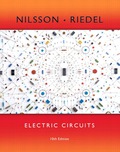
EBK ELECTRIC CIRCUITS
10th Edition
ISBN: 8220100801792
Author: Riedel
Publisher: YUZU
expand_more
expand_more
format_list_bulleted
Concept explainers
Question
Chapter 10, Problem 63P
a)
To determine
Calculate the value of turn’s ratio, when the average power is delivered to
b)
To determine
Calculate the value of average power delivered to
c)
To determine
Calculate the value of voltage
d)
To determine
Calculate the percentage of power developed by the ideal current source, when it is delivered to the
Expert Solution & Answer
Want to see the full answer?
Check out a sample textbook solution
Students have asked these similar questions
NO AI WILL REJECT(using laplace table only)
NO AI WILL REJECT(using laplace table only)
NO AI WILL REJECT(using laplace table only)
Chapter 10 Solutions
EBK ELECTRIC CIRCUITS
Ch. 10.2 - For each of the following sets of voltage and...Ch. 10.2 - Compute the power factor and the reactive factor...Ch. 10.3 - The periodic triangular current in Example 9.4,...Ch. 10.5 - The voltage at the terminals of a load is 250...Ch. 10.5 - Find the phasor voltage Vs in the circuit shown if...Ch. 10.6 - Find the average power delivered to the 100Ω...Ch. 10.6 - Find the average power delivered to the 400Ω...Ch. 10.6 - Prob. 11APCh. 10 - Prob. 1PCh. 10 - A college student wakes up hungry. He turns on the...
Ch. 10 - Show that the maximum value of the instantaneous...Ch. 10 - A load consisting of a 480 Ω resistor in parallel...Ch. 10 - Prob. 5PCh. 10 - Prob. 6PCh. 10 - The op amp in the circuit shown in Fig. P10.8 is...Ch. 10 - Calculate the real and reactive power associated...Ch. 10 - Prob. 9PCh. 10 - The load impedance in Fig. P10.10 absorbs 6 kW and...Ch. 10 - A personal computer with a monitor and keyboard...Ch. 10 - Prob. 12PCh. 10 -
The periodic current shown in Fig. P10.12...Ch. 10 - Find the rms value of the periodic voltage shown...Ch. 10 - Prob. 15PCh. 10 - Prob. 16PCh. 10 - The current Ig in the frequency-domain circuit...Ch. 10 - Prob. 18PCh. 10 - Find VL (rms) and θ for the circuit in Fig. P10.17...Ch. 10 - Find the average power, the reactive power, and...Ch. 10 -
Two 480 V (rms) loads are connected in parallel....Ch. 10 -
The two loads shown in Fig. P10.22 can be...Ch. 10 - Prob. 23PCh. 10 - Prob. 24PCh. 10 - Prob. 25PCh. 10 - Prob. 26PCh. 10 - Prob. 27PCh. 10 - Three loads are connected in parallel across a 300...Ch. 10 - The three loads in Problem 10.28 are fed from a...Ch. 10 - The three loads in the circuit in Fig. P10.27 can...Ch. 10 - Find the average power dissipated in the line in...Ch. 10 - Prob. 32PCh. 10 - Prob. 33PCh. 10 - A factory has an electrical load of 1600 kW at a...Ch. 10 - Prob. 35PCh. 10 - Prob. 36PCh. 10 - Find the average power delivered to the 8 Ω...Ch. 10 - Prob. 38PCh. 10 - Find the average power dissipated in each resistor...Ch. 10 - Prob. 40PCh. 10 - Prob. 41PCh. 10 - Prob. 42PCh. 10 - Prob. 43PCh. 10 - Prob. 44PCh. 10 - Prob. 45PCh. 10 - The variable resistor in the circuit shown in Fig....Ch. 10 - Prob. 47PCh. 10 - Prob. 50PCh. 10 - Prob. 51PCh. 10 - The 160 Ω resistor in the circuit in Fig. P10.51...Ch. 10 - Prob. 53PCh. 10 - Prob. 54PCh. 10 - The values of the parameters in the circuit shown...Ch. 10 - Prob. 57PCh. 10 - Prob. 58PCh. 10 - Prob. 59PCh. 10 - Prob. 60PCh. 10 - Prob. 61PCh. 10 - The ideal transformer connected to the 5 kΩ load...Ch. 10 - Prob. 63PCh. 10 - Prob. 64PCh. 10 - Prob. 67PCh. 10 - Prob. 68PCh. 10 - Prob. 69PCh. 10 - Prob. 70PCh. 10 - Prob. 71P
Knowledge Booster
Learn more about
Need a deep-dive on the concept behind this application? Look no further. Learn more about this topic, electrical-engineering and related others by exploring similar questions and additional content below.Similar questions
- 3.arrow_forward4. For the circuit in figure below, choose the load impedance Z₁ so that the power dissipated in it is a maximum. How much power will that be? 3 ΚΩ 15/0° V 26 ΚΩ 20001x j4 kQ 000 ZLarrow_forward1. In the phasor-domain shown in the figure, V = 120 20° V, I = 0.3 230° A, w = 1000 rad/s, R1 = 200 0, R2 = 2002, R3 = 1.2 kQQ, L =0.2 H, and C = 10 µF. Determine the complex power, average power and reactive power for each passive element. R₁ R₂ L ww ell R3arrow_forward
arrow_back_ios
SEE MORE QUESTIONS
arrow_forward_ios
Recommended textbooks for you
 Introductory Circuit Analysis (13th Edition)Electrical EngineeringISBN:9780133923605Author:Robert L. BoylestadPublisher:PEARSON
Introductory Circuit Analysis (13th Edition)Electrical EngineeringISBN:9780133923605Author:Robert L. BoylestadPublisher:PEARSON Delmar's Standard Textbook Of ElectricityElectrical EngineeringISBN:9781337900348Author:Stephen L. HermanPublisher:Cengage Learning
Delmar's Standard Textbook Of ElectricityElectrical EngineeringISBN:9781337900348Author:Stephen L. HermanPublisher:Cengage Learning Programmable Logic ControllersElectrical EngineeringISBN:9780073373843Author:Frank D. PetruzellaPublisher:McGraw-Hill Education
Programmable Logic ControllersElectrical EngineeringISBN:9780073373843Author:Frank D. PetruzellaPublisher:McGraw-Hill Education Fundamentals of Electric CircuitsElectrical EngineeringISBN:9780078028229Author:Charles K Alexander, Matthew SadikuPublisher:McGraw-Hill Education
Fundamentals of Electric CircuitsElectrical EngineeringISBN:9780078028229Author:Charles K Alexander, Matthew SadikuPublisher:McGraw-Hill Education Electric Circuits. (11th Edition)Electrical EngineeringISBN:9780134746968Author:James W. Nilsson, Susan RiedelPublisher:PEARSON
Electric Circuits. (11th Edition)Electrical EngineeringISBN:9780134746968Author:James W. Nilsson, Susan RiedelPublisher:PEARSON Engineering ElectromagneticsElectrical EngineeringISBN:9780078028151Author:Hayt, William H. (william Hart), Jr, BUCK, John A.Publisher:Mcgraw-hill Education,
Engineering ElectromagneticsElectrical EngineeringISBN:9780078028151Author:Hayt, William H. (william Hart), Jr, BUCK, John A.Publisher:Mcgraw-hill Education,

Introductory Circuit Analysis (13th Edition)
Electrical Engineering
ISBN:9780133923605
Author:Robert L. Boylestad
Publisher:PEARSON

Delmar's Standard Textbook Of Electricity
Electrical Engineering
ISBN:9781337900348
Author:Stephen L. Herman
Publisher:Cengage Learning

Programmable Logic Controllers
Electrical Engineering
ISBN:9780073373843
Author:Frank D. Petruzella
Publisher:McGraw-Hill Education

Fundamentals of Electric Circuits
Electrical Engineering
ISBN:9780078028229
Author:Charles K Alexander, Matthew Sadiku
Publisher:McGraw-Hill Education

Electric Circuits. (11th Edition)
Electrical Engineering
ISBN:9780134746968
Author:James W. Nilsson, Susan Riedel
Publisher:PEARSON

Engineering Electromagnetics
Electrical Engineering
ISBN:9780078028151
Author:Hayt, William H. (william Hart), Jr, BUCK, John A.
Publisher:Mcgraw-hill Education,
Types of Energy for Kids - Renewable and Non-Renewable Energies; Author: Smile and Learn - English;https://www.youtube.com/watch?v=w16-Uems2Qo;License: Standard Youtube License